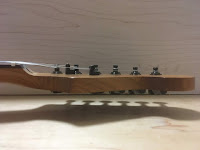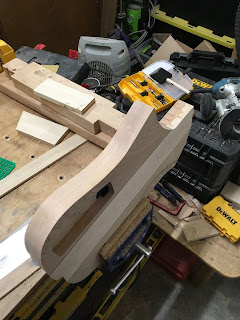So first I needed to finish cutting the cavity for the controls in the back. The procedure was basically the same as before although I free handed the curve along the outer edge of the guitar . . . thought that making a template was too much work and with a sharp bit and careful thin passes that turned out to be true . . . it wasn't completely smooth but some sandpaper takes care of that . . . and it's the inside.
 Next, well the cable run from the rear pickup to the control cavity (painted with shielding paint here . . . and the hole for the bridge ground . . . Done, ready for the ceremony.
Next, well the cable run from the rear pickup to the control cavity (painted with shielding paint here . . . and the hole for the bridge ground . . . Done, ready for the ceremony.
And it pratically impossible to have enough clamps. The boards put pressure on the middle of the glue up . . . important to keep everything flat . . .
So while waiting for the glue to dry I tackled another project that had been kicking around for quite some time. My JM has staggered Gotoh HAMP tuners . . . advertising says that they don't need string trees . . . advertising may be right in some cases but that group doesn't include mine. Since I got them installed they look good & function well . . . BUT . . . the D string has been twanging behind the nut pretty much since I got the nut set up. Now I COULD just take a couple of winds around the post tho bring the break angle up but that kinda defeats the purpose of locking tuners. Thus back to string trees, the 'problem' is that the hardware is Cosmo Black (aka black chrome) ... try finding some roller string trees in that (hint Gotoh doesn't make any, and what they do make does not roll, though it's OK probably. Finally find some chinese ones that looked likely on ebay . . . and once they arrived they have been kicking around in my box for ....
So her they are ... AFTER ... some judicious use of a file on the left example . . . if I want to stagger them and have the same break angle on all 4 strings and have the stings exit parallel to the headstock to the tuners some modifications were needed.
And here they are installed, looks good (even if the screws are still flat black (and half a size to small). More important, the twang seems to be GONE.
After that it was time for operation drip control . . . the starting situation on the left . . . and mostly cleaned up on the right. For the eagle eyed, the glue up was indeed not perfect there is a slight glue line indicating that I need to do a better job flattening the parts before putting them together , , , I may but a 1/8 (or 1/16) wood binding there to hide the boo boo if everything else works out fine . . . I 'll just need to do a better job next time . . .















